
The tournament hype before the 2014 GEICO Bassmaster Classic predicted loads of big bass and plenty of heavy limits. It was a lot to live up to.
Despite the coldest winter in decades and frigid water temperatures, Guntersville put on a show.
When the battle for Classic glory was over, the top nine finishers averaged over 20 pounds a day. Adam Wagner in 10th place missed that mark by less than a pound.
The Champ
Atop the heap was Alabamian Randy Howell who sacked the heaviest limit of his 21-year professional career on the final day of the Guntersville Classic, 29 pounds, 2 ounces. Howell was fortunate to have his biggest catch on bass fishing’s grandest stage, but it was hardly luck.
Howell’s experience was the reason he made the right adjustments at the right time. After the practice days preceding the Classic, Howell’s best spot was a submerged milfoil patch in 3 to 4 feet of water on a flat in a creek.
The grass only covered a 50-yard square of the bottom, but it held some heavyweights. Howell started there on the first morning of the tournament. He caught a 6-pounder and another that went 4 pounds on a bladed jig.
Then the bite died. Rainfall the night before had pushed muddy water over the grassbed. Howell changed gears and began cranking a Rapala DT-6 in the bright red Demon color tight to riprap banks. A slow retrieve enticed the bites he needed from the sluggish, cold-water bass.
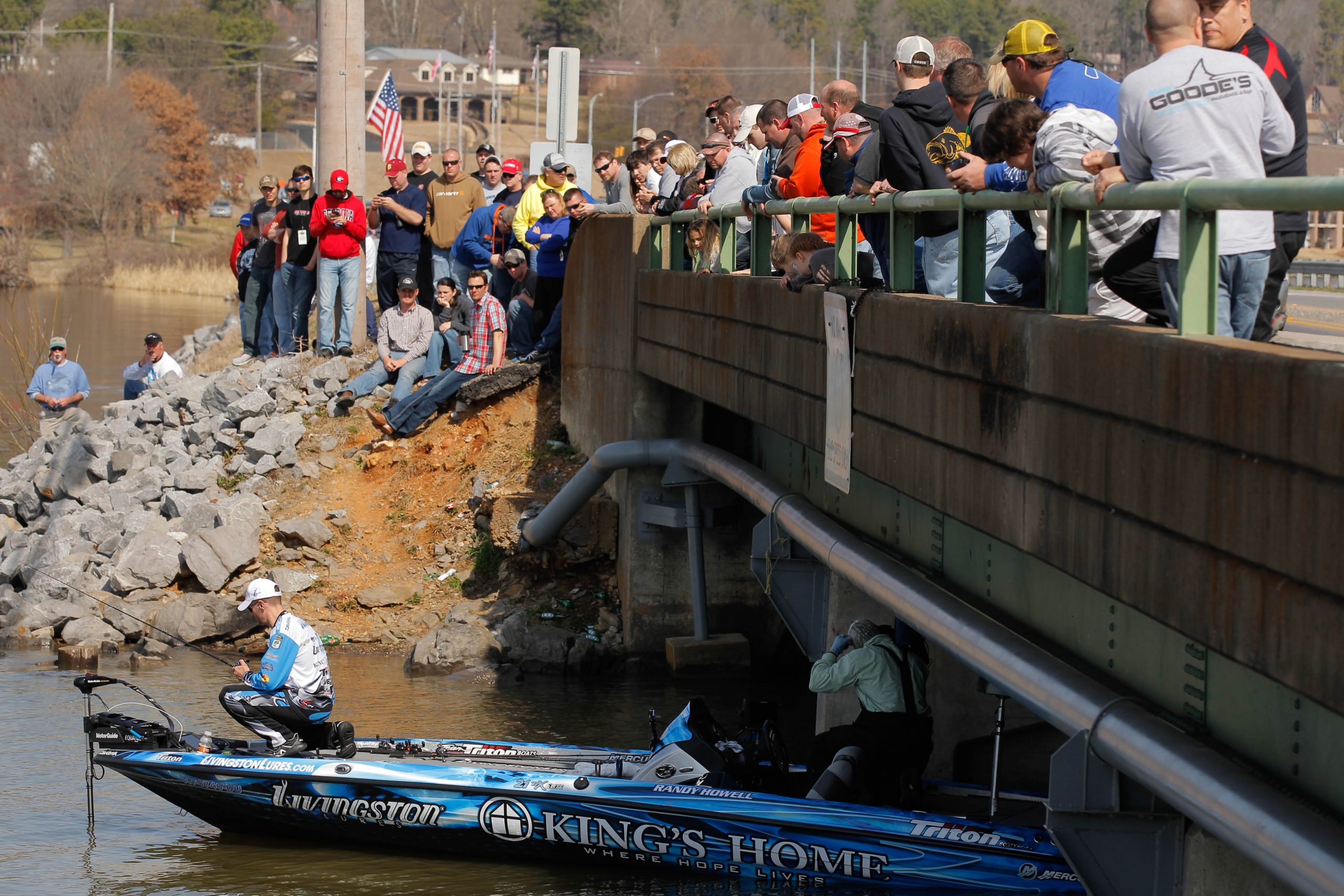 Guntersville’s riprap is known for producing big catches, but it hadn’t been kind to Howell on practice days.
Guntersville’s riprap is known for producing big catches, but it hadn’t been kind to Howell on practice days.
“I could see all kinds of shad and bass hanging 8 to 12 feet deep along the riprap with my Lowrance SideScan,” Howell said.
He tried to catch them with crankbaits and other lures in that depth range, but the bass refused his offerings. Thankfully for Howell, the warming water pulled the bass up in Mill Creek the first day where he picked them off with the DT-6.
Late the second day, Howell snatched a 5-pound bass from the riprap in Spring Creek. That bass prompted Howell to start in Spring Creek the next day, which resulted in his amazing finish.
After catching a good limit on the DT-6, Howell noticed bass on his graph that were hanging just off the rocks 8 feet deep. That’s when he did the unthinkable, which was switching to a prototype Livingston crankbait that he had never fished before. The lure’s running depth, hard wobble and electronic shad sound proved to be just what the bass wanted.
“I was paralleling the riprap and hitting rocks 7 to 10 feet deep,” Howell said.
Howell believes that the lure’s wide, hard wobbling action coupled with the electronic baitfish sound it emits played into his success. By the end of the day he was throwing back 4-pound bass without giving them a second thought.
“It was one of the best days of my life,” Howell said.
The Contender
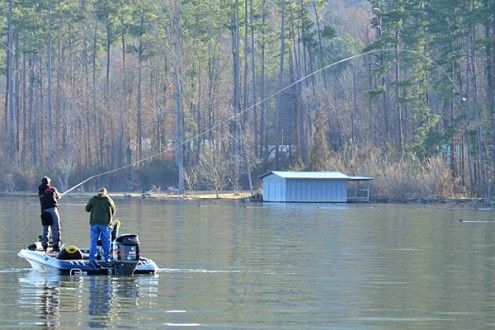 B.A.S.S. Nation champion Paul Mueller, who hails from Connecticut, had what may have been the most reliable pattern during the Guntersville Classic. His key area had a mix of ridges and ledges 3 to 9 feet deep intersected by a creek channel.
B.A.S.S. Nation champion Paul Mueller, who hails from Connecticut, had what may have been the most reliable pattern during the Guntersville Classic. His key area had a mix of ridges and ledges 3 to 9 feet deep intersected by a creek channel.
“It had the healthiest eelgrass I had found and there was some hydrilla mixed in with it,” Mueller said.
On all three days of the Classic, Mueller feathered the top of the grass with a 3/4-ounce Strike King Red Eye Shad. He also caught some of his bass on a 3/8-ounce Z-Man Original Chatterbait dressed with a Reins Fat Rockvibe Shad.
“The biggest thing that helped me was the Navionics Platinum card in my Lowrance graph,” Mueller said. “The contour lines showed where the points and turns were in the grass. Those irregularities are where I caught all my biggest fish.”
Steady Eddy
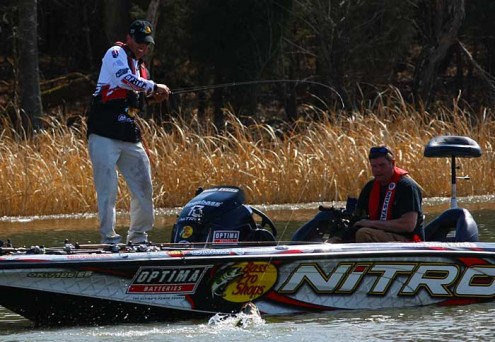 Edwin Evers fell short of winning the Classic at Guntersville by less than 2 pounds and finished third. He is surely one of the best anglers to ever wear the B.A.S.S patch.
Edwin Evers fell short of winning the Classic at Guntersville by less than 2 pounds and finished third. He is surely one of the best anglers to ever wear the B.A.S.S patch.
Unlike Howell, who relied on riprap, and Mueller, who keyed on main lake eelgrass, Evers plucked his bass from shallow grassbeds in “pockets” off the main lake.
One of his key pockets was a flat in a backwater where submerged milfoil and hydrilla were growing in 2 to 4 feet of water. This is where he mopped up with a 3/8-ounce Megabass Flat Slap in the GP Sexy Shad color.
A thin, tight-wobbling, shad profile bait, the Flat Slap runs 3 to 4 feet deep. A slow retrieve with frequent pauses did the trick for Evers. He added lead tape to the Flat Slap’s belly so it would suspend when paused.
“That bait stays horizontal when you stop it,” Evers said. “That’s when all the bites happened.”
Gator grass in 1 to 3 feet of water also produced bass for Evers. This was especially true on the final day when he caught all the bass that he brought to the scales on a bladed jig dressed with a Megabass Spark Shad.
“The bass moved shallower every day,” Evers said.
Breakfast of Champions
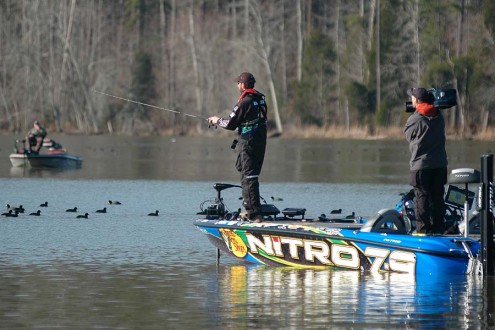 One of the most nervy times for the pros during the Guntersville Classic was when they lined their boats up at the official ramp before take-off. Loud rock and country music blared from loudspeakers, thousands of fans lined the bank and writers and cameramen swarmed the pros for photos and interviews.
One of the most nervy times for the pros during the Guntersville Classic was when they lined their boats up at the official ramp before take-off. Loud rock and country music blared from loudspeakers, thousands of fans lined the bank and writers and cameramen swarmed the pros for photos and interviews.
While all this was happening, Tennessee’s Ott DeFoe would calmly munch on a Pop Tart like he didn’t have a care in the world. His steady disposition is surely a big part of the reason for his bass fishing success.
One lure accounted for the bulk of the bass that carried DeFoe to fourth place at the Classic. It was a Rapala DT-6, custom painted by Gordon Monroe to resemble a pumpkinseed sunfish.
Over the first two days, DeFoe slowly ground the DT-6 over riprap along causeways. He eased his boat down the riprap within a few feet of the rocks and cast the crankbait close to the shoreline. Then he held his rod low and close to the riprap so he could slowly work the crankbait into every crevice.
He paused often to let the crankbait float up out of trouble. Even though DeFoe fished with delicate precision, he snagged frequently. However, he never showed any irritation. It was all in a day’s work.
DeFoe started out cranking riprap on Day 3. He quickly boated a keeper, but had nothing else to show 4 hours later. It was time to punt.
DeFoe fled the riprap and motored to a grass ridge on the main lake that was 4 to 6 feet deep. The grass was just beginning to grow there and stood only 8 to 12 inches tall.
It was slow going, but DeFoe was relentless. He tried a variety of lures, including a small swimbait and a jerkbait, but the DT-6 did most of the damage.
Only six bass got a tour of DeFoe’s livewells that day, including his last bass, an 8-pounder. One more like that and DeFoe would have been the champion.
Home Boy
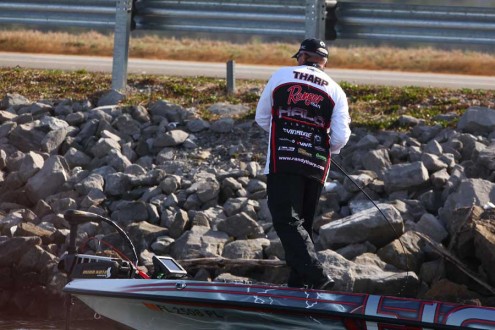 Randall Tharp resides in Florida, but he knows Guntersville so well that the other pros feel he had a home field advantage. A mix of milfoil and eelgrass 4 to 7 feet deep on the main lake produced most of Tharp’s 62 pounds, 12 ounces.
Randall Tharp resides in Florida, but he knows Guntersville so well that the other pros feel he had a home field advantage. A mix of milfoil and eelgrass 4 to 7 feet deep on the main lake produced most of Tharp’s 62 pounds, 12 ounces.
“I was sitting in about 10 feet and casting over the grass,” Tharp said. “A Rapala DT-6 was strong in practice, but an XCalibur Xr50 caught 90 percent of the bass I weighed in.”
The Xr50 is a lipless rattling crankbait. Tharp fished it in the Royal Shad color and retrieved the bait very slowly. When it contacted the grass, he would pull it through the vegetation and let it fall.
“That’s when most of the bites happened,” Tharp said.
After catching a good limit from the grass, Tharp would run back close to the official ramp and work riprap banks with Spro’s McStick 110 in the Blue Bandit color. This allowed him to cull at least one fish each day.
“I know the key places on those long straightaway banks where the bass pull up and feed,” Tharp said.
Late on the final day, Tharp knew he needed one or two kicker bass to have a shot at winning the Classic. He almost pulled it off by pitching a jig into wood cover off the main lake. He hooked and lost three bass, including a giant largemouth that hung up in a limb and shook free.
Tharp will never forget that bass.





